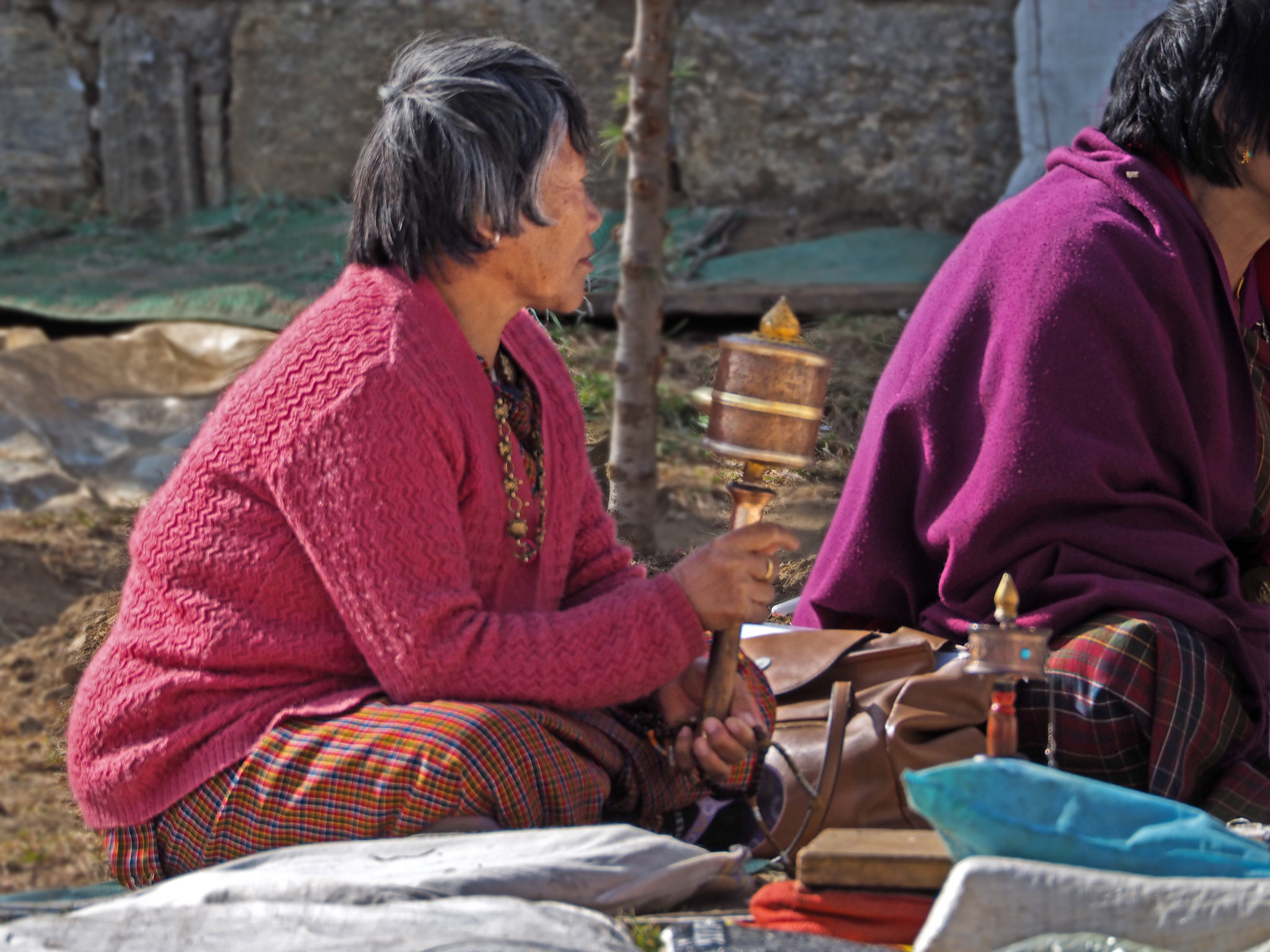 The Buddha Dordenma is an iconic monument sitting atop a forest hill overlooking Bhutan’s capital city of Thimphu. Viewable from any part of the city, the massive statue of Shakyamuni is sited amidst Kuensel Phodrang where the palace of Sherab Wangchuck (the thirteenth Desi Druk who ruled the country from 1744 to 1763) once stood. It is one of the largest Buddha Rupas (or statues) in the world measuring at a height of 51.5 metres. Made of bronze and gilded in gold, the statue alone cost USD$47 million. Manufactured in China, the statue was cut into pieces and then transported to site through Phuentsholing (imagine the awe of wide-eyed Bhutanese villagers seeing the gigantic head of Buddha at the back of a moving lorry, priceless).
The Buddha Dordenma is an iconic monument sitting atop a forest hill overlooking Bhutan’s capital city of Thimphu. Viewable from any part of the city, the massive statue of Shakyamuni is sited amidst Kuensel Phodrang where the palace of Sherab Wangchuck (the thirteenth Desi Druk who ruled the country from 1744 to 1763) once stood. It is one of the largest Buddha Rupas (or statues) in the world measuring at a height of 51.5 metres. Made of bronze and gilded in gold, the statue alone cost USD$47 million. Manufactured in China, the statue was cut into pieces and then transported to site through Phuentsholing (imagine the awe of wide-eyed Bhutanese villagers seeing the gigantic head of Buddha at the back of a moving lorry, priceless).
This is part of a greater whole, which includes the Kuensel Phodrang Nature Park, a 943-acre nature park inaugurated in 2011 to preserve the forests surrounding the statue. The entire project, which took about 10 years to complete on 25 September 2015, cost over USD$100 million. Locals and tourists alike embrace the park, which is popular for weekend family outings and its biking, hiking and nature trails. The park also hosted the Peling Tsechu, a three-day festival held in May 2016 to commemorate the birth of His Royal Highness Gyalsey Jigme Namgyel Wangchuck. The three-storey base houses a large chapel, while the body itself is filled with 125,000 gold statues of Buddha. The statue is expected to be a major pilgrimage centre and a focal point for Buddhists all over the world to converge, practice, meditate, and retreat.
The three-storey base houses a large chapel, while the body itself is filled with 125,000 gold statues of Buddha. The statue is expected to be a major pilgrimage centre and a focal point for Buddhists all over the world to converge, practice, meditate, and retreat. Apart from commemorating the 60th birth anniversary of Bhutan’s fourth king Jigme Singye Wangchuck, it fulfills two prophecies. In the twentieth century, the renowned yogi Sonam Zangpo prophesied that a large statue of either Padmasambhava, Buddha or of a phurba would be built in the region to bestow blessings, peace and happiness to the entire world. The statue itself is mentioned in an ancient terma of Guru Padmasambhava himself, said to date from approximately the 8th century, and recovered some 800 years ago by Terton Pema Lingpa (Religious Treasure Discoverer).
Apart from commemorating the 60th birth anniversary of Bhutan’s fourth king Jigme Singye Wangchuck, it fulfills two prophecies. In the twentieth century, the renowned yogi Sonam Zangpo prophesied that a large statue of either Padmasambhava, Buddha or of a phurba would be built in the region to bestow blessings, peace and happiness to the entire world. The statue itself is mentioned in an ancient terma of Guru Padmasambhava himself, said to date from approximately the 8th century, and recovered some 800 years ago by Terton Pema Lingpa (Religious Treasure Discoverer). For me, I am just happy to be blessed with such an amazing view.
For me, I am just happy to be blessed with such an amazing view. The Buddha Dordenma overlooks the Southern entrance to Thimphu Valley, and visitors can enjoy a vantage view of Thimphu nestled in the valley below.
The Buddha Dordenma overlooks the Southern entrance to Thimphu Valley, and visitors can enjoy a vantage view of Thimphu nestled in the valley below. Thimphu being the capital city is the most developed and densely populated area in Bhutan, so this sight of closely-packed buildings is not the norm in other parts of the country which are mostly mountains, forests and farmlands. With urbanization, Bhutanese youths are increasingly migrating to Thimphu in search of white-collar jobs and a better life. I wonder how many dreams these buildings hold?
Thimphu being the capital city is the most developed and densely populated area in Bhutan, so this sight of closely-packed buildings is not the norm in other parts of the country which are mostly mountains, forests and farmlands. With urbanization, Bhutanese youths are increasingly migrating to Thimphu in search of white-collar jobs and a better life. I wonder how many dreams these buildings hold?
 One thing I know for sure, Bhutan is not ready to give up their unique cultural identity for modernization, and the little kingdom is gingerly treading the waters of urbanization, step by step, without compromising on the values which they have held closely for centuries. If there is a country left in the world who can find a delicate balance between culture and economic progress, it would be Bhutan.
One thing I know for sure, Bhutan is not ready to give up their unique cultural identity for modernization, and the little kingdom is gingerly treading the waters of urbanization, step by step, without compromising on the values which they have held closely for centuries. If there is a country left in the world who can find a delicate balance between culture and economic progress, it would be Bhutan.
Buddha Dordenma
Opening Hours: 9:00AM to 5:00PM daily
Website: www.buddhadordenma.org
More of my travel adventures in Bhutan
Tag Archives: culture
Bhutan – The Craft of Tsho Lham Bootmaking
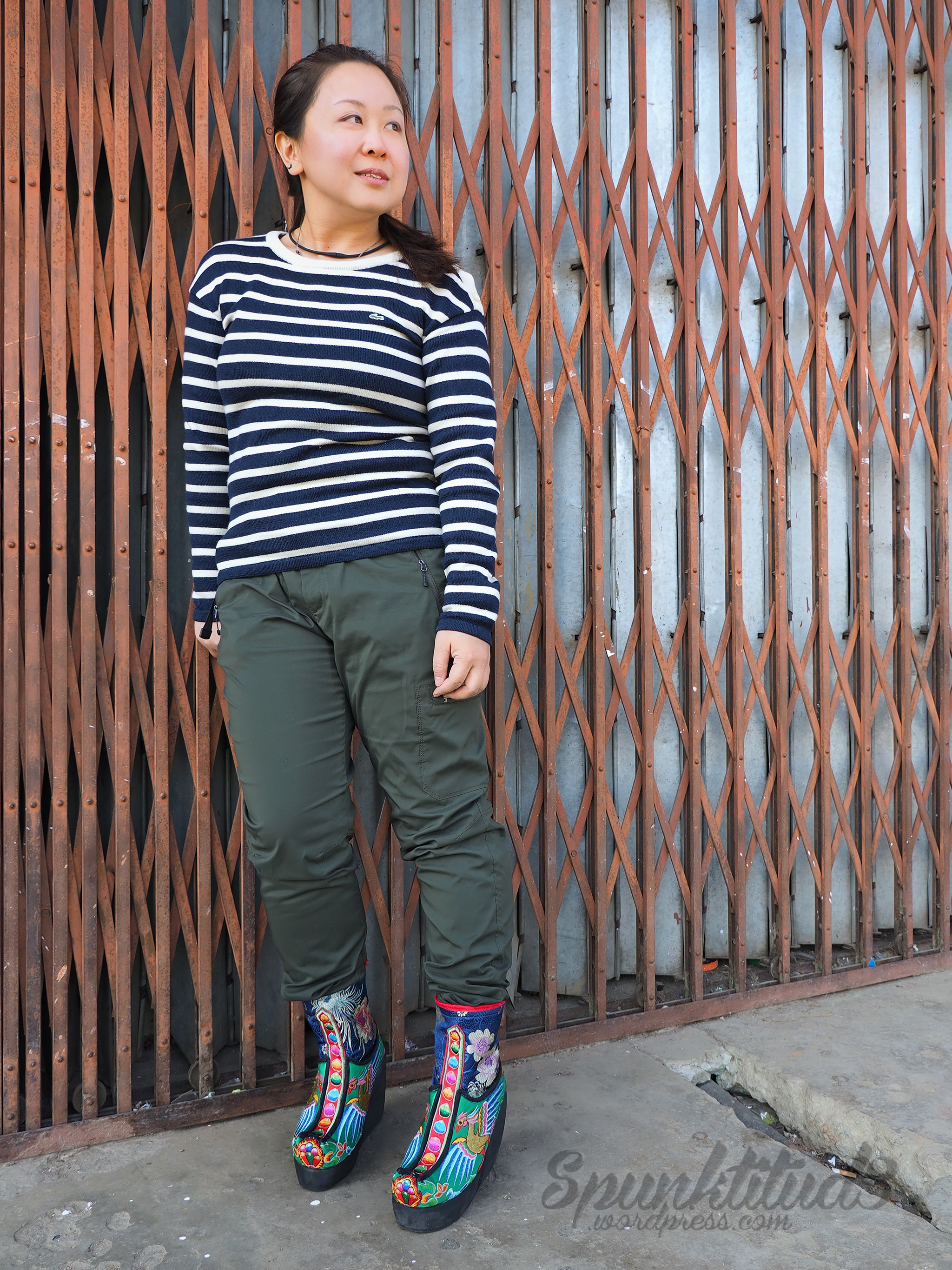 Something which I really wanted from Bhutan were their traditional boots – it was love at first sight when I first saw them on the feet of a Bhutanese gentleman some time ago. To me, it felt like wearing like an amalgamation of Bhutan’s rich cultural heritage on my feet. Plus they made me look five inches taller LOL.
Something which I really wanted from Bhutan were their traditional boots – it was love at first sight when I first saw them on the feet of a Bhutanese gentleman some time ago. To me, it felt like wearing like an amalgamation of Bhutan’s rich cultural heritage on my feet. Plus they made me look five inches taller LOL.
 I asked my guide at least six times when we were going to buy my boots from the moment I arrived. At last we came to a traditional boot-making shop in the capital city of Thimphu.
I asked my guide at least six times when we were going to buy my boots from the moment I arrived. At last we came to a traditional boot-making shop in the capital city of Thimphu.
 Apart from boots, the shop makes ceremonial face masks that are used at tshechus (festivals).
Apart from boots, the shop makes ceremonial face masks that are used at tshechus (festivals).
These traditional knee-length boots known as tshoglham, came to Bhutan with Zhabdrung (great Tibetan lamas) in 1616. They were worn by Bhutanese men (usually noblemen) during formal and festive occasions, and they were padded with aromatic pine needles for warmth and comfort. The present King of Bhutan attended his coronation wearing a pair of traditional Bhutanese boots designed by Italian fashion house Salvatore Ferragamo.
(Images from Kuensel and Italy Magazine)
As the craft of boot-making (tsho lham) involves needlework on leather and silk, it is categorized under the art of appliqué and embroidery (tshem zo) in Zorig Chusum, the Thirteen Traditional Crafts of Bhutan. Craftsmen in the villages also make simple boots from uncured leather.
 One interesting fact that I discovered – culturally, tshoglhams are worn by people according to their social status. The colour of the middle part of the boot (tshoglham kor) designates the rank of the wearer – yellow is reserved for the King and Je Khenpo (Chief Abbot), orange for ministers, red for high-ranking officials, blue for members of the Parliament or National Council, and green for normal citizens. And that, I only knew after an excruciating 20 minutes of trying to decide which colour to choose. Looks like it was a no-brainer from the start afterall lol.
One interesting fact that I discovered – culturally, tshoglhams are worn by people according to their social status. The colour of the middle part of the boot (tshoglham kor) designates the rank of the wearer – yellow is reserved for the King and Je Khenpo (Chief Abbot), orange for ministers, red for high-ranking officials, blue for members of the Parliament or National Council, and green for normal citizens. And that, I only knew after an excruciating 20 minutes of trying to decide which colour to choose. Looks like it was a no-brainer from the start afterall lol.
 By the end of the 20th century, only ministers (lyonpo or lyonchhen) and Dasho (royal government officials awarded the honorary title by the King) were the only people left wearing these boots, and the craft of boot-making faced the threat of dying out. Traditional boot-making involves very time-consuming and difficult work, and the demand for such boots is undeniably small, being limited to dancers, high-ranking monks and officials who need no more than two pairs in a lifetime, as well as the occasional tourist.
By the end of the 20th century, only ministers (lyonpo or lyonchhen) and Dasho (royal government officials awarded the honorary title by the King) were the only people left wearing these boots, and the craft of boot-making faced the threat of dying out. Traditional boot-making involves very time-consuming and difficult work, and the demand for such boots is undeniably small, being limited to dancers, high-ranking monks and officials who need no more than two pairs in a lifetime, as well as the occasional tourist.
The relatively high price of these boots also make them unaffordable for most Bhutanese – an ordinary pair cost about 1,800 Bhutanese Ngultrums (USD30), and can go up to over 6,000 Bhutanese Ngultrums (USD150) for a more elaborately embroided and quality pair. (The average monthly disposable income of a Bhutanese is about USD235.24) Hence, the craftsmen also face the threat of much cheaper tsholghams from Kalimpong and Jaigon, West Bengal.
As people gradually preferred more comfortable and practical styles of footwear – there was only one Royal Bootmaker Shabgye Tshoglam Wangdi left in the whole of Bhutan and he was unable to find any apprentices to pass on his craftsmanship to. Ap Wangdi had learnt the craft from a master in Tibet and was the only person who could make tshoglhams for the members of the royal family and senior civil servants.
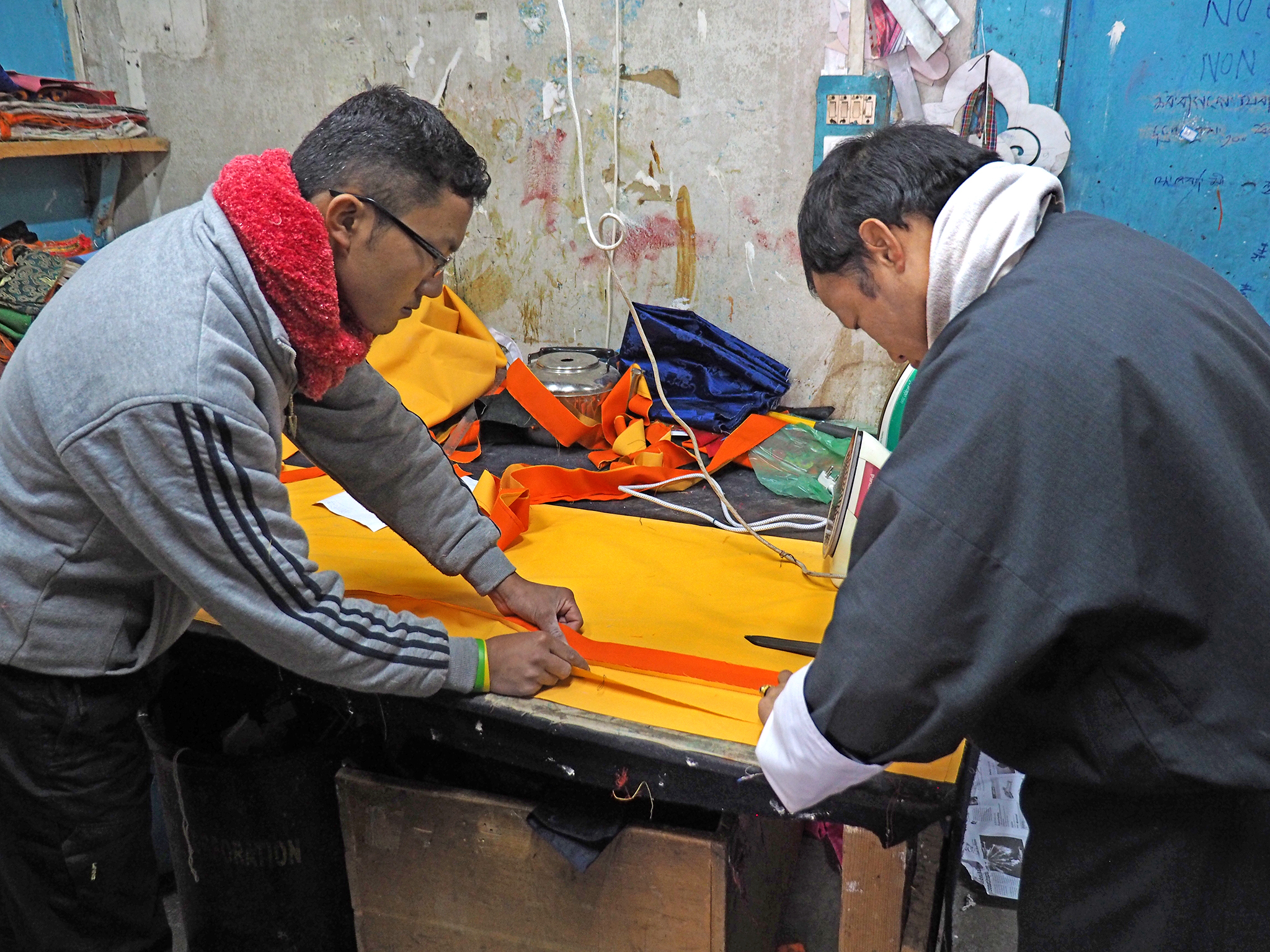 The revival of this craft finally caught the attention of the Bhutanese government, who in 1999 invited Ap Wangdi, through the Nationel Technical Training Authority (NTTA) to teach the art of bootmaking at the Zorig Chusum Institute. By 2002, five masters and 16 apprentices were produced at the Institute.
The revival of this craft finally caught the attention of the Bhutanese government, who in 1999 invited Ap Wangdi, through the Nationel Technical Training Authority (NTTA) to teach the art of bootmaking at the Zorig Chusum Institute. By 2002, five masters and 16 apprentices were produced at the Institute.
 To create work for the new craftsmen, the Royal Civil Service Commission then established a code of etiquette where civil servants were required to wear tshoglhams during official events, thus creating demand for these young bootmakers.
To create work for the new craftsmen, the Royal Civil Service Commission then established a code of etiquette where civil servants were required to wear tshoglhams during official events, thus creating demand for these young bootmakers.
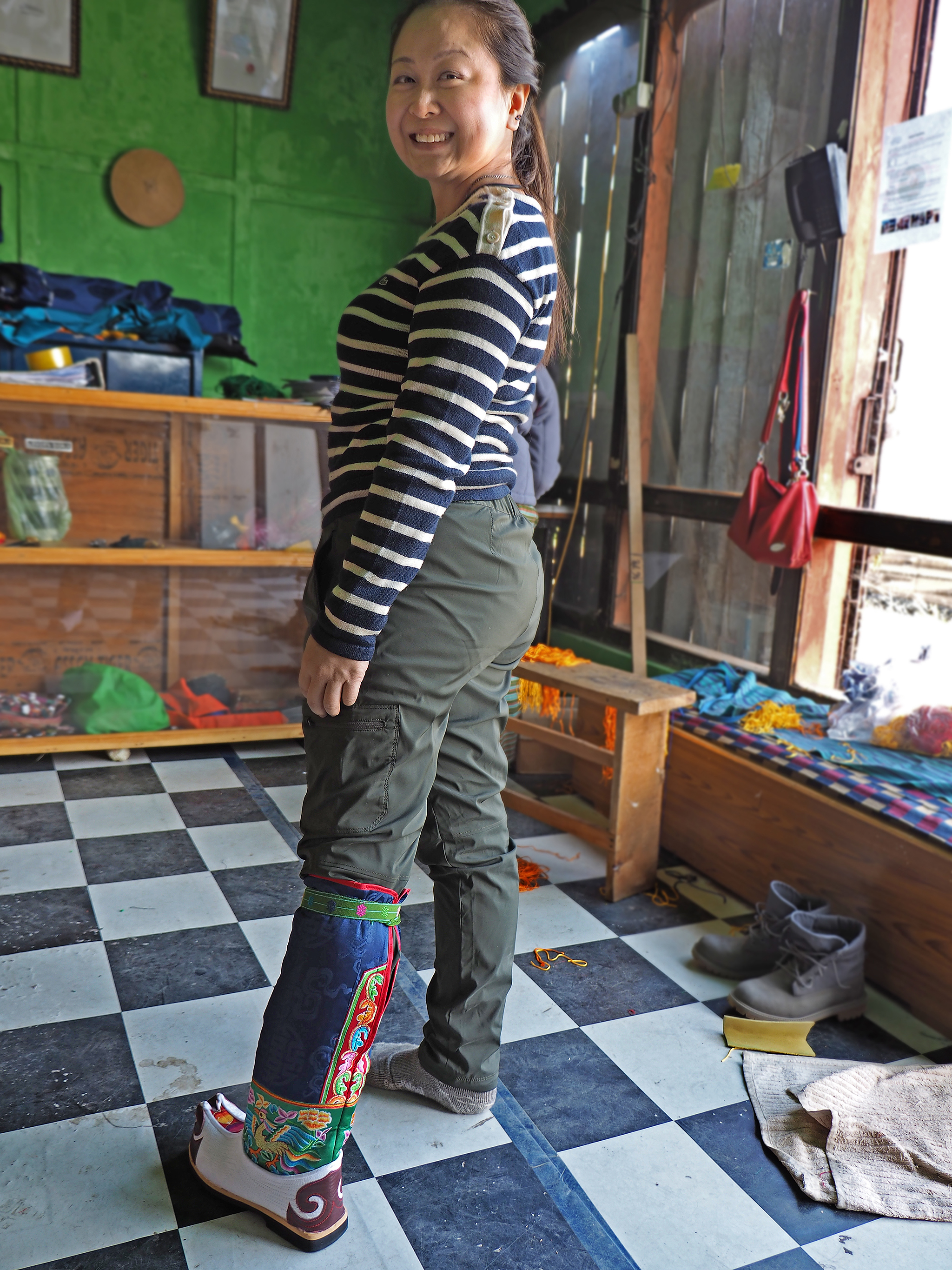 HAPPINESS! Simply elated I finally got my boots. Each pair is tailor-made to your measurements, and take from 4 days to 2 weeks on average to make depending on the complexity of the design and availability of the craftsmen.
HAPPINESS! Simply elated I finally got my boots. Each pair is tailor-made to your measurements, and take from 4 days to 2 weeks on average to make depending on the complexity of the design and availability of the craftsmen.
Although the main design of tshoglham has not changed, the materials have changed – thin leather soles have been replaced with thick rubber soles to make them more comfortable, and customers can bring their own design for the shaft of the boot or request to add zippers. Lham, the female version of tshoglhams, are being designed and recently, half-tshoglhams have also surfaced. While it is inevitable that footwear needs to evolve with the modern times, we need to be mindful that an item with that much cultural heritage and tradition is not drastically altered.
 For me, I will stick to the traditional tshoglham. This original tall shaft design is typically worn by men, while the modern ones with high heels or platforms are for women (so they can look taller!). I would have bought every colour available if not for the fact that I was only allowed to buy the civilian green colour (yes culture does come before money for the Bhutanese). So looking forward to strutting down the street with a representation of Bhutan at my feet :)
For me, I will stick to the traditional tshoglham. This original tall shaft design is typically worn by men, while the modern ones with high heels or platforms are for women (so they can look taller!). I would have bought every colour available if not for the fact that I was only allowed to buy the civilian green colour (yes culture does come before money for the Bhutanese). So looking forward to strutting down the street with a representation of Bhutan at my feet :)
More of my travel adventures in Bhutan
Bhutan, Thimphu – National Memorial Chorten
The National Memorial Chorten is one of the most prominent religious structures located in Bhutan’s capital city of Thimphu, and a focus of daily worship for many Bhutanese.
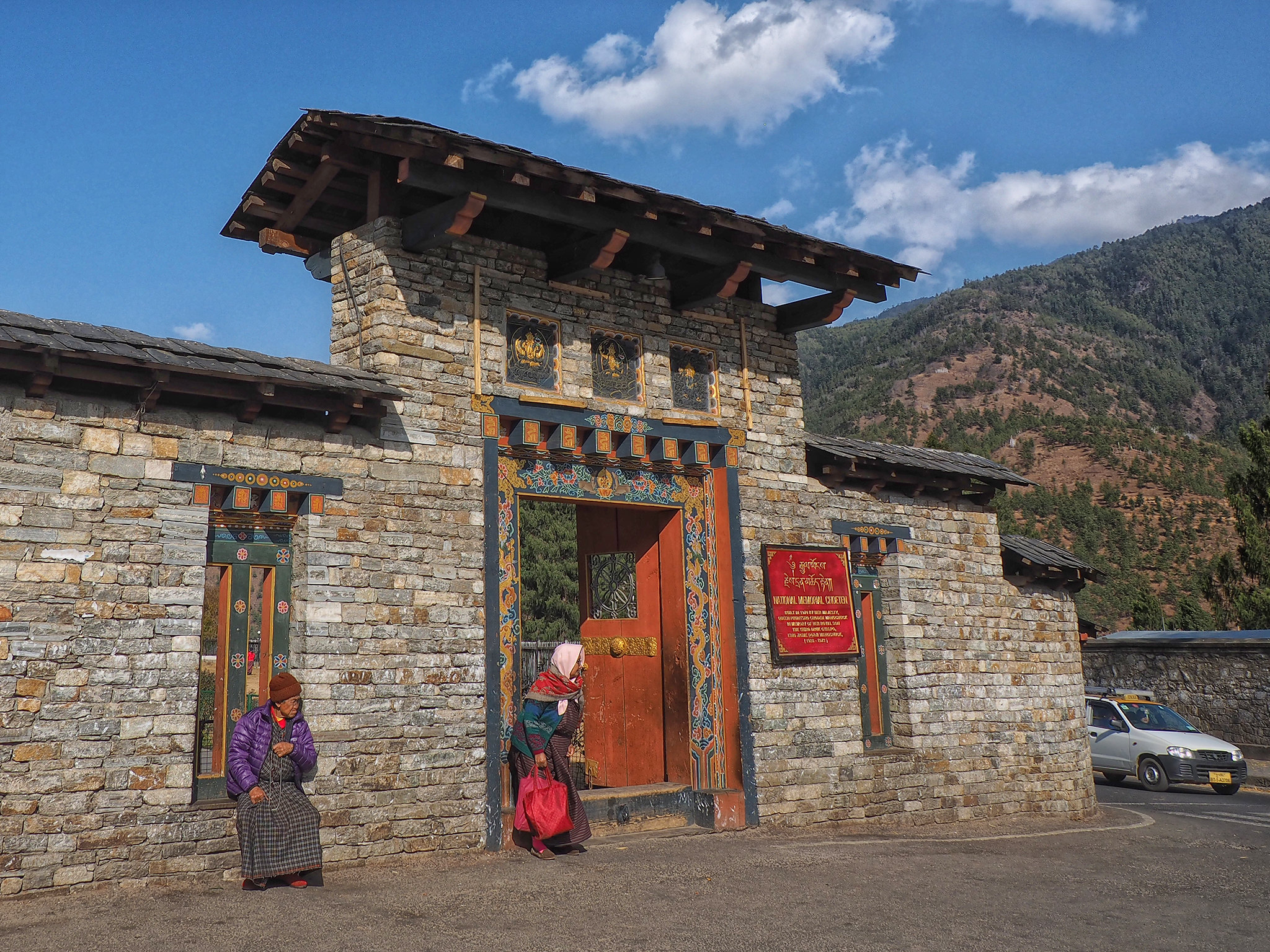 Elderly ladies at the entrance of the National Memorial Chorten
Elderly ladies at the entrance of the National Memorial Chorten
 The Tibetan-style chorten (or ‘stupa’ in Hindi) was built by Her Majesty the late Queen Ashi Phuntsho Choden Wangchuck for her son, Bhutan’s third king, His Majesty Jigme Dorji Wangchuck (“the father of modern Bhutan”) and built in 1974, two years after his death. It was the late King’s wish to build such a chorten to represent the mind of the Buddha and dedicated to world peace.
The Tibetan-style chorten (or ‘stupa’ in Hindi) was built by Her Majesty the late Queen Ashi Phuntsho Choden Wangchuck for her son, Bhutan’s third king, His Majesty Jigme Dorji Wangchuck (“the father of modern Bhutan”) and built in 1974, two years after his death. It was the late King’s wish to build such a chorten to represent the mind of the Buddha and dedicated to world peace.
Every day from dawn till dusk old people and young alike circumambulate the chorten turning the large red prayer wheels, or chanting with their mala prayer beads or mini handheld mani prayer wheels. On auspicious days, religious ceremonies and initiations are also conducted at the chorten.
 The Bhutanese are highly pious, and many elderly people come here from dawn and stay for most of the day, chanting.
The Bhutanese are highly pious, and many elderly people come here from dawn and stay for most of the day, chanting.
 Most of the devotees come in a group, and have picnics on the chorten grounds. I would say it’s one of the best form of community bonding for the locals.
Most of the devotees come in a group, and have picnics on the chorten grounds. I would say it’s one of the best form of community bonding for the locals.
Almost everyone has a mani prayer wheels with them, spinning them in a clockwise direction to release their prayers to heaven. Repeatedly inscribed with Buddhist mantras, these wheels are especially useful for the illiterate since according to Tibetan Buddhist belief, spinning a prayer wheel is just as effective as reciting the sacred texts aloud. This enables the individual to become awakened and realize the Four Immeasurables of Love, Compassion, Joy and Equanimity, thus assisting their journeys to enlightenment.
 Boy playing with the many, many birds at the chorten’s little garden
Boy playing with the many, many birds at the chorten’s little garden
 Bhutanese child in modern attire. While the adults typically go to religious places in their traditional attire, I spotted many kids in modern wear.
Bhutanese child in modern attire. While the adults typically go to religious places in their traditional attire, I spotted many kids in modern wear.
Devotee with the statue of Goddess Ihamu at the front of the chorten. I wonder what’s on his mind…
Chorten literally means ‘Seat of Faith’ and this whitewashed chorten decorated with its richly carved annexes facing the four directions is an extraordinary example of Buddhist architecture and artwork with its gorgeous paintings, elaborate mandalas and intricate sculptures. All the four sides of the chorten have different mandalas & statues dedicated to the third king.
Unlike other chortens, the National Memorial Chorten does not enshrine human remains – only Druk Gyalpo’s photo in a ceremonial dress adorns a hall in the ground floor.
The basic structure of a Chorten consists of a square foundation symbolizing the earth, a dome symbolizing water, and thirteen tapering steps of enlightenment symbolizing the element of fire. There are eight different kind stupas, all referring to major events in Buddha Shakyamuni’s life.
Numerous religious paintings and complex tantric statues housed inside reflect both peaceful and wrathful aspects of Buddhist deities, with some 36 of them in erotic poses. The inside of the Chorten opens only once a year for locals & tourists during the Monlam Prayer festival, usually held during the 4th to 11th day of the first Tibetan month when the Je Khenpo (religious head of Bhutan) addresses and gives blessings the people present for the occasion.
 All day long, devotees circle the chorten in a leisurely clockwise direction, praying for blessings. The atmosphere is serene yet relaxed.
All day long, devotees circle the chorten in a leisurely clockwise direction, praying for blessings. The atmosphere is serene yet relaxed.
 Students and office workers stop by in the morning or during lunch breaks to pray for their respective needs.
Students and office workers stop by in the morning or during lunch breaks to pray for their respective needs.
 Elderly man repeatedly prostrating
Elderly man repeatedly prostrating
 Religion being highly embedded into the Bhutanese way of life, visiting places of worship like this one is a regular family affair to pray for good fortune, apart from pujas (religious rites).
Religion being highly embedded into the Bhutanese way of life, visiting places of worship like this one is a regular family affair to pray for good fortune, apart from pujas (religious rites).
 For the foreign visitor in me, I enjoyed the serenity and unhurried pace at the National Memorial Chorten, while quietly admiring the architecture of the religious monuments. For a moment, I felt like I was part of the local community. Maybe I should bring some tea and join them on my next visit, I would love to hear their stories :)
For the foreign visitor in me, I enjoyed the serenity and unhurried pace at the National Memorial Chorten, while quietly admiring the architecture of the religious monuments. For a moment, I felt like I was part of the local community. Maybe I should bring some tea and join them on my next visit, I would love to hear their stories :)
National Memorial Chorten
Address: Chhoten Lam, Thimphu, Bhutan
More of my travel adventures in Bhutan
Seoul, Korea – Woo Lae Oak 우래옥: The House of Many Returns
Naengmyeon 냉면, or cold buckwheat noodles, is one of the most ubiquitous traditional summer food in Korea. Interestingly, this dish first appeared in North Korea as a specialty dish that was eaten only during the winter. It can now be found throughout Korea year-round, and one of the most famous restaurants serving this humble dish in Seoul is Woo Lae Oak 우래옥 (又来屋,which means House of Many Returns ). Opened in the pre-Korean War era in 1946, it is one of the few places in the city that serves authentic North Korean Pyeongyang-style naengmyeon. For the older generation Northerners, it is also a nostalgic reminder of the home they left behind during the war.
To get to Woo Lae Oak, take the subway to Euljiro-4-ga Station, Line 2 & 5, Exit 4. I wish the “Sewing Factory” shop just opposite the road abundant prosperity and be in business for a long long time, cos’ it is the best landmark along the endless row of shops :p
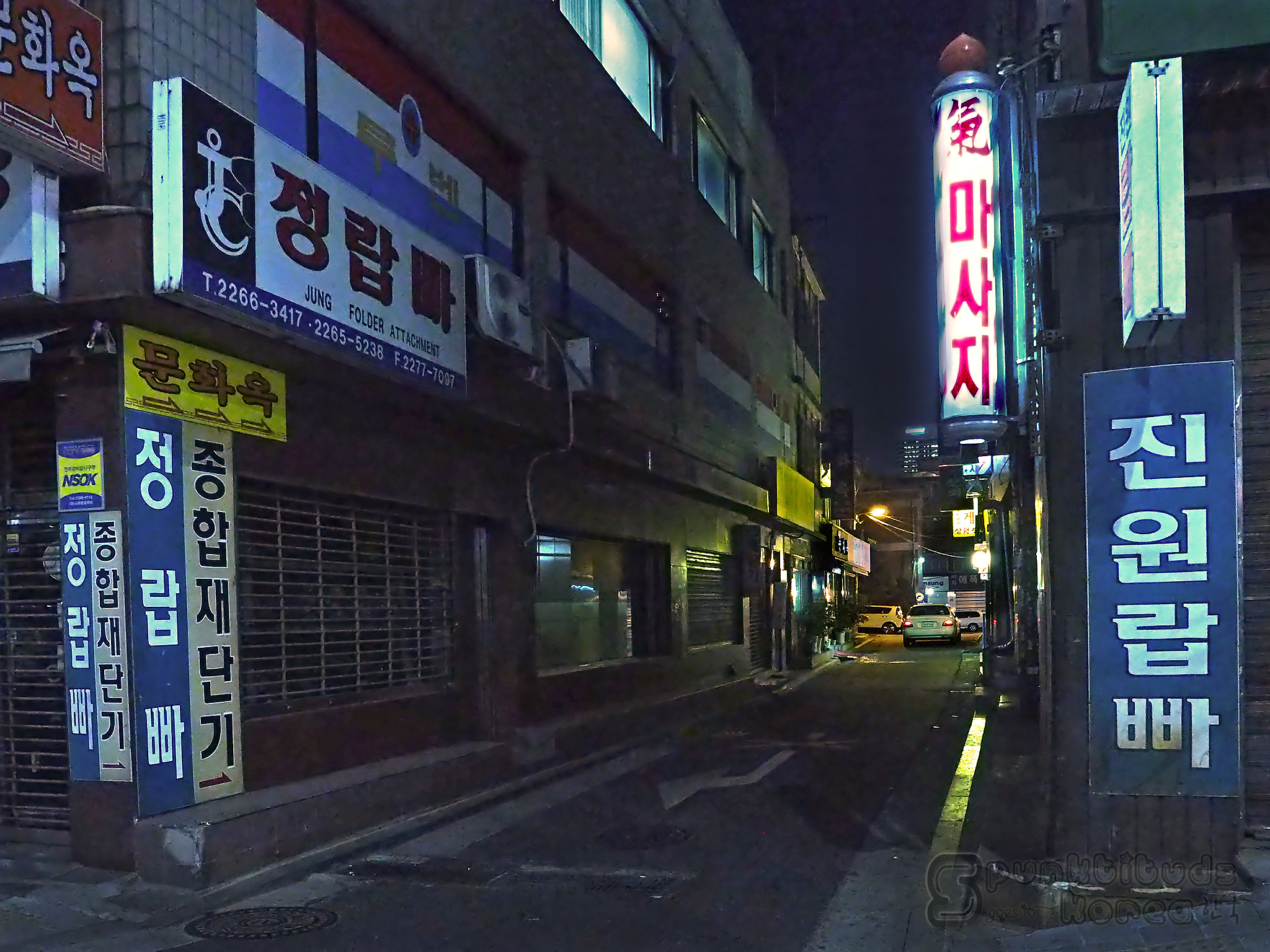
Walk straight for about 10 metres from Exit 4 and turn right at the first alley you see. Go 50 metres further and turn left at the first alley. 
Voila – right before you is the famous Woo Lae Oak. It was freezing that night, but I was determined to taste the naengmyung which came highly recommended by the owner of the Hanok (traditional Korean house) I was staying at.
 You are greeted by a wall of awards and commendations just as you enter the restaurant.
You are greeted by a wall of awards and commendations just as you enter the restaurant.

Besides its famous Pyeongyang Naengmyeon, other popular dishes include Bulgogi (pan-fried beef), Yukhoe (sliced raw beef), North-Korean style Bok Jaeng Ban (steamed sliced beef in broth) and Chap Chae (stirfried vermicelli noodles with beef & vegetables).

The restaurant’s founder, Chang Won-il, moved his family from Pyongyang to Seoul after World War II, and opened Seo Lae Oak (House from the West) specializing in bulgogi and naengmyun in 1946 with much success. The beginning of the Korean War which started shortly after forced the family close its business to seek refuge, only returning to re-establish their popular restaurant at the same place after the war ended and changing to its current name Woo Lae Oak, meaning “House of Return”. I was surprised to see that the restaurant looks upscale as I was expecting a more traditional and boisterous atmosphere.

With its storied reputation, eating at Woo Lae Oak is a meal infused with culture, and nostalgic for its older North Korean customers.

Time to satiate those hunger pangs!
 An ubiquitous dish to start every Korean meal – kimchi
An ubiquitous dish to start every Korean meal – kimchi

What’s special about naengmyeon at Woo Lae Oak is that its noodles are made to order each time. It is also made of 100% buckwheat, giving the noodles a soft and earthy flavour. A rich beef stock is used instead of traditionally used pheasant stock (which some may find the taste too gamey).
There are basically two types of naengmyeon, differeing in the way they are served – Pyeongyang naengmyeon (mul naengmyeon) is served in a chilled broth (above) and Hamheung naengmyeon (bibim naengmyeon) comes topped with Korean chilli paste. Both versions are usually garnished with cliced beef, boiled egg, cucumber and strips of crunchy pear.
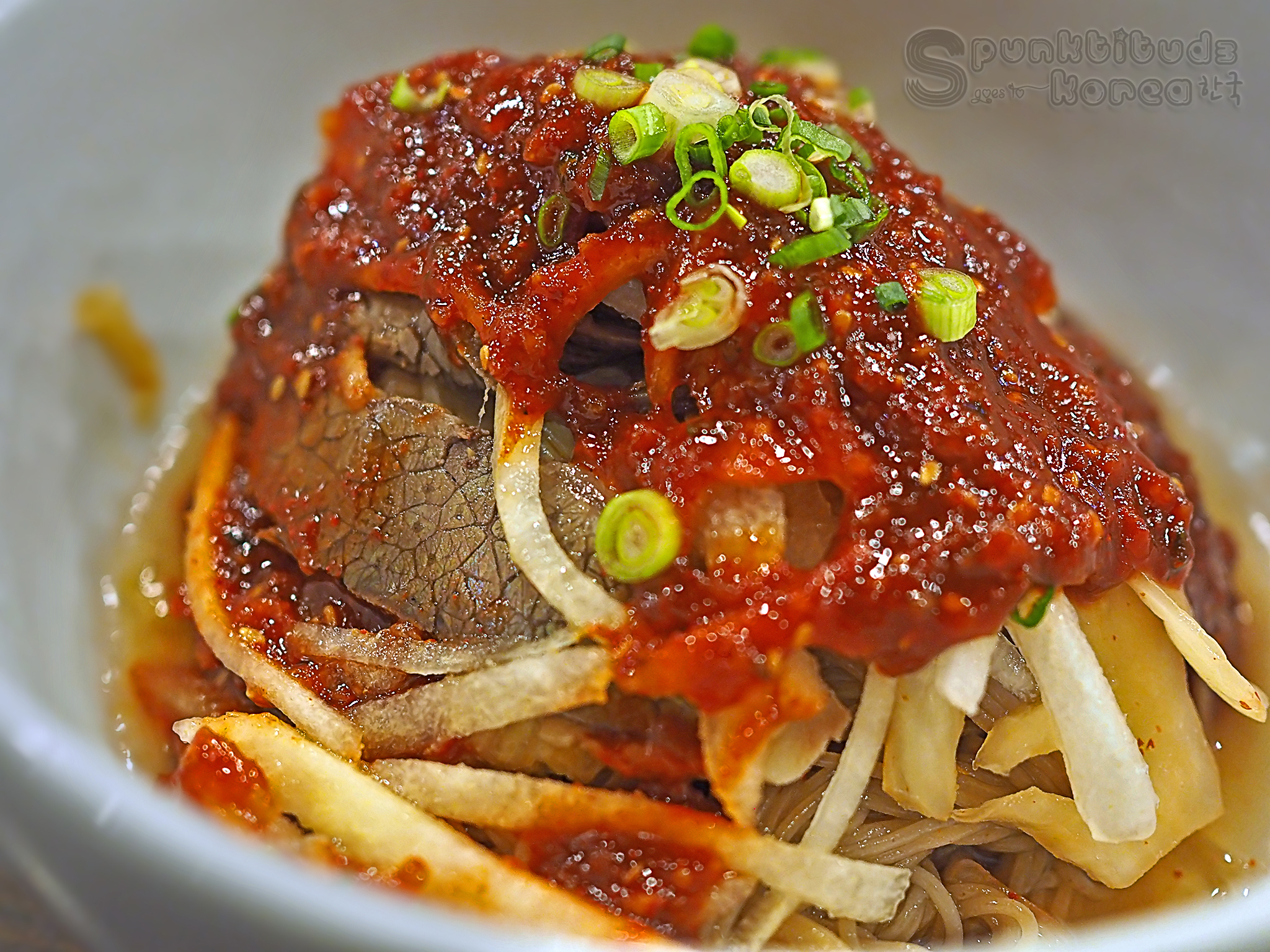
A fiery-red Hamheung naengmyeon which tastes less potent than it looks.

Mix it up and slurp away! I enjoyed this version more as I like some spice in my food. The noodles had a firm yet smooth bite.
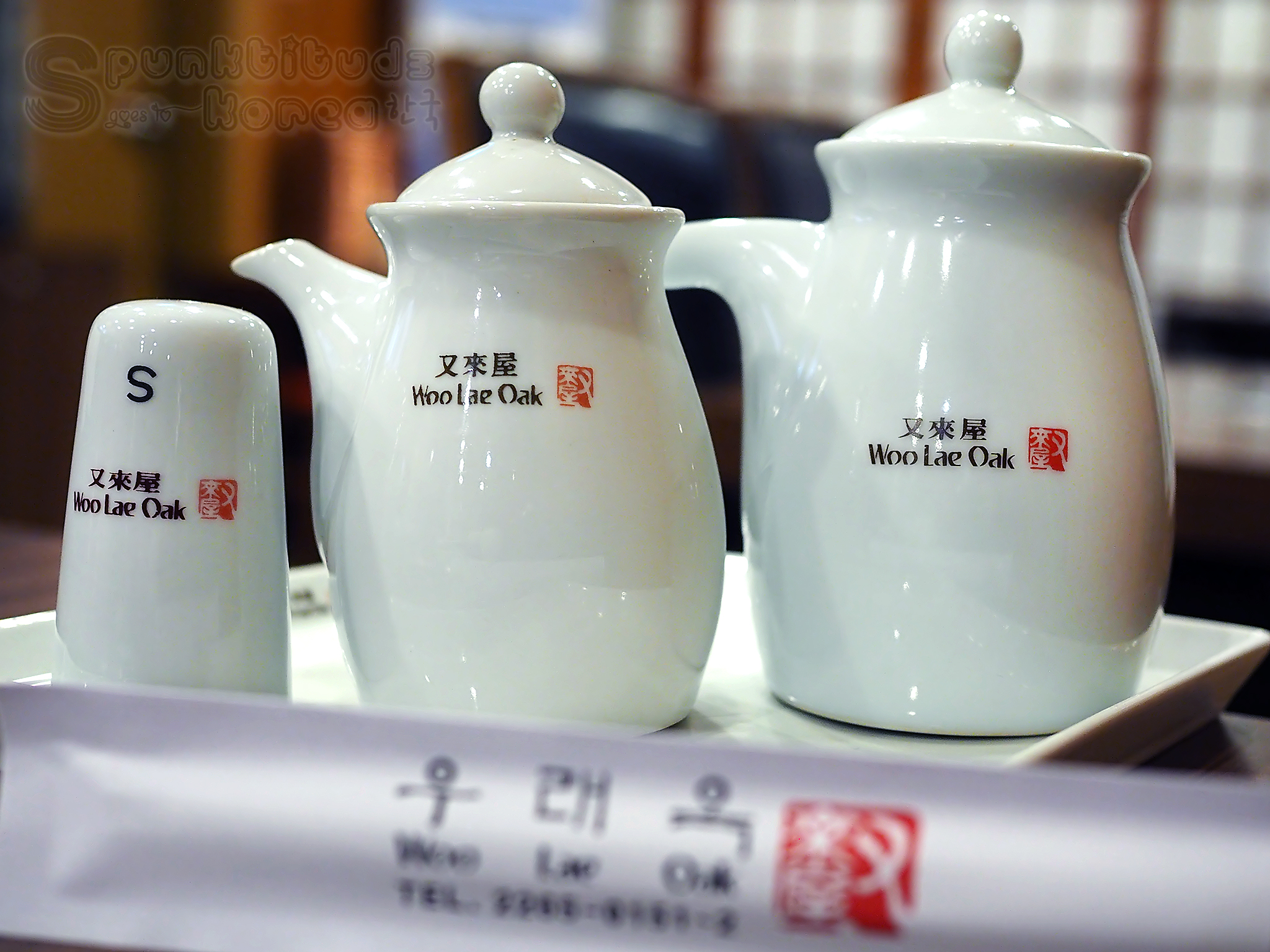
While keeping close to its 69-year-old roots, Woo Lae Oak has opened several branches in the United States, all run by members of Chang Won-il’s family. They readily admit that the American outlets’ food tastes different because Korean ingredients are not readily available. Until I get a chance to visit Okryugwan restaurant in North Korea, the origin of naengmyeon (it is said that the late leader Kim Il Sun instructed that the distinctive taste of Okryugwan naengmyeon be preserved forever), Woo Lae Oak would be the closest I can get to tasting a slice of North Korean culture.
Woo Lae Oak 우래옥
Address: 118-1, Jugyo-dong, Jung-gu, Seoul, South Korea (서울특별시 중구 주교동 118-1)
Subway: Euljiro-4-ga Station, Line 2 & 5, Exit 4. Walk straight for about 10 metres and turn right at the first alley you see. Go 50 metres and turn left into the first alley you see.
Opening Hours: 11:30AM to 9:30PM (Last order 9:00PM); Closed on Monday, Seollal Lunar New Year 설날 (1 January) & Chuseok Korean Thanks-giving 추석 (15th of August of the lunar calendar)
Reservations: +82 2 2265 0151 2 (in Korean; or you can try speaking in Chinese)
Wesite: http://우래옥주교점.com/index.php (in Korean)
Thailand – Tips to Enjoying Songkran!
One of the items on my bucket list is experiencing Songkran, otherwise known as the Thai New Year or Thailand Water Festival. Celebrated every 13-15 April, Thais traditionally celebrate by politely sprinkling water on the hands of family members and close friends for good blessing, pay their respects to Buddha and engage in merit-making. Today, visitors to the Land of Smiles would know Songkran more as a water play extravaganza rather than a cultural event with it taking on a more festive mood, where the gentle sprinkling on family elders’ hands transforms into dousing complete strangers with water hoses and Super Soakers. I hesistated going for a long time cos’ I heard that the locals only target pretty girls – what if I come home all nice and dry? That would be the biggest embarrassment of my life! So armed with a small bottle of water (just in case the ‘worst’ happens and I need to douse myself) and an adventurous spirit, I conquered my first Songkran with a group of fun pals.

Sawadee ka! We arrived a day earlier to suss out our ‘battlefield’. Look what I brought for a waterproof bag – a lunch warmer bag from Daiso lol! It worked beautifully :)
Songkran is celebrated in around Thailand, with major celebrations happening in Bangkok, Chiang Mai (the epicentre of Songkran), Hua Hin, Khon Kaen, Pattaya and Phuket. Smaller towns may celebrate in a more traditional and religious manner rather than water fights and merry-making. Half of Bangkok’s residents travel back to their home towns for family re-unions, but in their place an entire world of merrymakers descend upon the city like throngs of bees. Most offices, banks and shops/restaurants are closed during Songkran, so do ask if there is a particular shop/restaurant that you are planning to visit during your trip. Shopping malls and some stalls at Chatuchak do stay open.
Songkran, traditionally…
Until Thailand adopted the International Calendar, Songkran originally followed the solar calendar which meant it fell on different dates every year. Now it happens every 13-15 April, which means it’s easier for us to plan our holidays lol! The significance of the water festival is about cleansing, purification and receiving blessings for the new year. It is also a time for family reunions, temple visiting, doing good deeds and spring-cleaning the house.
Thais perform the Rod Nam Dum Hua ritual (National Elderly Day) on the first day of Songkran, where young people would sprinkle water into the elders’ palms as a form of respect and to ask for blessings. The second day of Songkran is National Family Day where families spend quality time together. The Thais would also partake in religious activities such as giving alms to the monks and ‘bathing’ Buddha statues both at home and at the temple as well as engage in merit-making activities during the festival.

Motorcyclists are splashed with glee, although this is not encouraged due to road safety concerns. This person was doused cos’ he stopped for the tuk-tuk in front.
Songkran now…as the world knows it
As the world gets to know of Songkran over the years, the festival starts to take on a more merry-making spirit, and splashing complete strangers with water has become the main attraction of the festival. Festivities have stretched to almost a week-long. The only constant is the symbolism of water washing away misfortunes in the past year, and welcoming the new year with good luck. Songkrans happens during the hottest time of the year too, so it’s the perfect time for water play!
Water fights take place in the form of water guns, buckets to merry-makers on pickups spraying pedestrains with garden hoses attached to a gallon of water. (Firetrucks also get into the action with their firehoses!) Some go for hardcore by adding ice in the water. People will also smear a white paste on your face, which is suppoused to bring protection and ward off bad spirits. I was more worried about welcoming pimples (which thankfully didn’t happen). As the night approaches, dancing and partying takes place till the wee hours, only to resume when day breaks. Wicked.

See what I meant by them only going for the pretty girls lol
Getting chased by revelers while walking on the street is a common sight

This Japanese tourist is no pushover – she retaliates with a fierce splash at the Thai stallowner! She couldn’t speak much English not Thai, but I could still clearly hear a “What the f***!” when she was ambushed with a splash haha. But it’s all in good fun.

Chatuchak turns into a battlezone
The splashing happens mainly around the building exterior, so quickly scoot inside the shops if you want to avoid the splashing. (although I doubt you will escape totally dry) Remember to ask the stall owners to give your purchases double protection.

Some nice stalls will put out a pail of water for revelers to refill their water guns. Thank you, you will be abundantly blessed for the new year!

Meanwhile, I indulge in my favourite cooling activity at Chatuchak – a chocolate-coated frozen banana, uber yummz! I also received a jasmine garland from a food stall there, so I smelled pretty awesome the entire day :)

The largest and wildest crowd in Bangkok has to be at Patpong/Silom near Sala Daeng BTS. I couldn’t believe the number of people in sight (this was taken when the crowds were already dispersing)! You can get a pretty good bird’s eye view of the merry-making on the second level walkway.
Otherwise head to Khao San Road to be in the thick of action. Both Silom and Khao San Road are closed to traffic for 2 days of festivities.

I wasted no time in getting ‘armed’ with a cute ladybug bought at the convenience stall. Water guns can cost anywhere from 199bht to 500bht (mine was 250 baht), and our experience was that street vendors might be more likely to charge more so get ready to bargain. You can check the ‘market rate’ for the various sizes at a nearby convenience stall before embarking on your bargaining.

The square at Silom BTS turns into a marketplace selling water guns, food and an endless supply of beer.

Watch out for passing vehicles spraying! This one caught us by surprise so I could only manage a ‘dreamy’ shot lol

We had the most fun at this little street we stumbled upon at Silom Road; it was lined with watering holes and lots of revelers! We enjoyed the action so much we went back the next night as well.

Tag team – A watergun in one hand and a pail of beer in the other
The good-natured Thais were always ready for a picture. In fact, a few tapped on my shoulder and insisted I take a picture of them :)
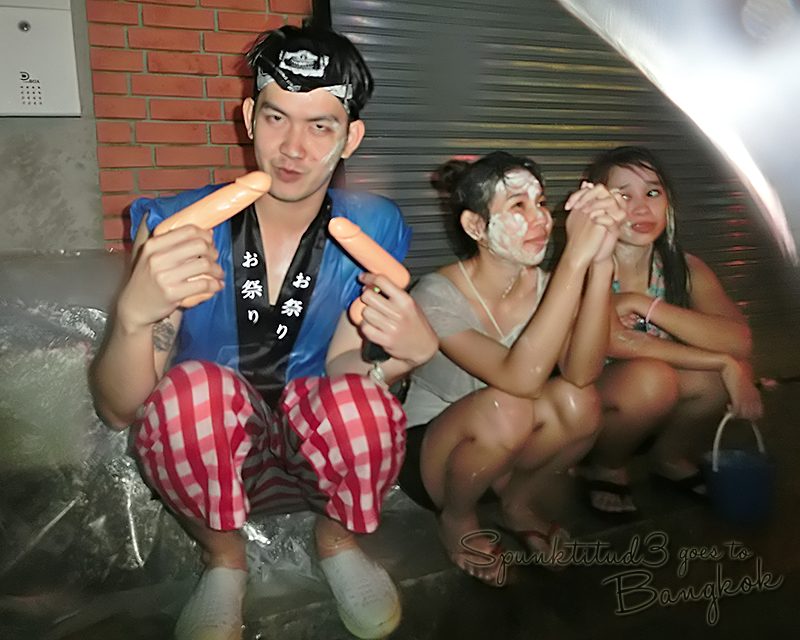
Hmmm, I think your tools are too tiny for a good fight, but very suggestive squirts indeed… I was more game to carry the squirting ice cream cone I got as a free gift hee.
Watch the ‘live’ action

We had so much fun! The festival brought our great teamwork amongst friends and we thoroughly enjoyed our times together. This will definitely not be the last Songkran we visit!
If water fights and partying are too wild for your liking, you can still celebrate Songkran the traditional way by visiting temples where they have religious activities. You can visit temples in the Rattanokosin area like Wat Pho, Wat Phra Kaeo, Wat Suthat Thepphawararam, Wat Chana Songkhram, Wat Boworn, Wat Benchamabophit, Wat Rakhang Khositaram, Wat Arun and Wat Kanlaya.
Songkran Survival Tips
- Keep all electronics and valuables in waterproof bags once you step out of the plane (you never know when you are gonna get splashed). There are street vendors selling waterproof vinyl bags for mobile phones if you forget to bring; for cameras I would strongly encourage you to bring or in desperate times, use Ziploc bags – they are a life saver.
- Go with a group of friends! You’ll have more fun during ‘water fights’ with comrades standing by you.
- Bring lightweight and cheap clothes, since you will be wet (& dirty) 80% of the time (20% is when you are sleeping or hiding in the malls). Do bring an extra set (or two) of clothes just in case your clothes do not dry in time. Otherwise, just buy there.
- Please, please put on some clothes – I have seen drenched men wearing only boxer shorts, and what I saw was enough to make me lose my appetite. Both lunch and dinner.
- Try not to bring too many things out as you will be busy dodging water pistols and to prevent pickpocketing.
- Take the public transport if you are heading out –traffic is paralyzed to a snail’s pace during festivities.
- You can bring your own water guns or easily buy one at a convenience stall/ along the streets.
- Do not throw dirty water – no one wants to smell like the sewer or grow pimples/rashes after!
- ‘Ammunition refill stations’ are aplenty – you can buy water from the numerous stores/street vendors who have set up stalls along the street, or simply buy a drink from the stall and politely ask to refill your water guns.
- Go easy on the splashing – Remember the main objective is to give others blessing, not start World War Three.
- After you have been splashed (blessed), wish the person “Sawasdee Pee Mai” which means “Happy New Year!” or “Suk San Wan Songkran” which means “Happy Songkran Day!”
- Do not throw water at motorcyclists or use whistles to stop them, to prevent road accidents. Every year, hundreds of motorists die during Songkran (granted half of them were drunk).
- Lock your car/taxi door – some over-enthusiastic/drunk reveler (occasionally) may attempt to open your car door to give you a splash.
- Drunken revelry is a big part of Songkran. Expect hordes of people dancing and drinking in the streets. If you are uncomfortable with such scenes, stay inside the shopping malls or your hotel (then why did you even bother to come during this period???). Also avoid Silom and Khao San Road, the main merry-making districts.
- Safety is of utmost importance – take care of your valuables and your chastity – my guy friend got molested when we went into an overly crowded street. If the person is too close for comfort, simply walk/run away.
- Visit a temple or give alms to a monk! Making merit is a key part of Songkran.
- Last and most importantly – Go in good spirit and have some good-natured fun; you’ll be abundantly blessed for the year to come! :)







